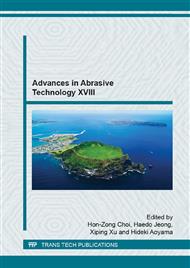p.54
p.60
p.66
p.71
p.78
p.84
p.90
p.97
p.104
Forces during Grinding Operation and its Relation to the Dressing Cycle
Abstract:
While grinding with CNC cylindrical grinding machines, there are many factors that determine the precision and accuracy of the finished product. These may include dimensional accuracy, surface roughness, circularity (roundness), cylindricity, etc. But all these factors pertain to the work. The condition of the tool, in this case, the cutting edges of the grinding wheel, also greatly influence the profile and precision of the work. So, in order to maintain the precision of the work, there is a need to repeatedly and regularly maintain the cutting edges in a good cutting condition, by the process of dressing. In other words, when the swarf gets adhered to the grinding wheel, the abrasive particles can no longer perform machining with the same efficiency, due to increase in contact surface area between the abrasive particles and the work. This dissertation describes a technique that can be adopted to continuously monitor the grinding forces generated during the grinding operation, by using an in-process 2-dimensional piezoelectric force sensor, which can simultaneously measure the force and break it down into its two force components. The force sensor not only calculates the force generated, but also quantifies the force variation. By analyzing the variation in the radial and tangential force components individually, and by conducting Fourier analysis on the observed data, it is found that deterioration of the grinding wheel and the dress pattern can be continuously monitored and controlled.
Info:
Periodical:
Pages:
78-83
Citation:
Online since:
January 2016
Price:
Сopyright:
© 2016 Trans Tech Publications Ltd. All Rights Reserved
Share:
Citation:


